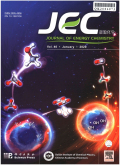- 钛学术文献服务平台 \
- 学术期刊 \
- 工业技术期刊 \
- 石油与天然气工业期刊 \
- 能源化学期刊 \
Catalytic role of assembled Ce Lewis acid sites over ceria for electrocatalytic conversion of dinitrogen to ammonia
Catalytic role of assembled Ce Lewis acid sites over ceria for electrocatalytic conversion of dinitrogen to ammonia
基本信息来源于合作网站,原文需代理用户跳转至来源网站获取
摘要:
CeO2-based catalysts are emerging as novel candidates for catalyzing nitrogen reduction reaction(NRR).However,despite the increasing amount of experimental and theoretical research,the design of more efficient ceria catalysts for NRR remains a challenge due to the poor knowledge of the catalytic mecha-nism,particularly the nature of the active sites and how they catalyze NRR.Here,using first-principle cal-culations,we investigated the NRR catalysis process involving adjacent Ce Lewis acid clusters formed on(111),(110),and(100)facets of CeO2 as active sites.Our results revealed that the assembled structures of the Ce Lewis acid as active centers after the oxygen vacancies(Ovs)were opened.The exposed Ce sites on CeO2(111),CeO2(110),and CeO2(100)can cause N2 to be adsorbed in a"lying-down"manner,which facil-itates the N2 activation and thus leads to much higher NRR activity.Furthermore,from the perspective of electronic structure,we establish two useful descriptors for assessing the NRR activity on ceria with Ovs:The N-N bond strength of the adsorbed N2 and the adsorption energy of the *N2H intermediate.This work thus provides direct guidance for the design of more-effective oxide catalysts without the use of scarce metals.

推荐文章
Rock chemical weathering by sulfuric acid: pathway, method and prospect
Chemical weathering
Sulfuric acid
Global climate change
Sulfate isotope
IP over SDH技术研究
IP、SDH系统、IP over SDH
IP over DWDM技术研究
IPoverDWDM
光网络
网络结构
广电IP over SDH的应用探讨
IP over SDH
PPP协议
高速路由器
内容分析
关键词云
关键词热度
相关文献总数
(/次)
(/年)
引文网络
引文网络
二级参考文献 (0)
共引文献 (0)
参考文献 (0)
节点文献
引证文献 (0)
同被引文献 (0)
二级引证文献 (0)
2021(0)
- 参考文献(0)
- 二级参考文献(0)
- 引证文献(0)
- 二级引证文献(0)
引文网络交叉学科
相关学者/机构
期刊影响力
能源化学
主办单位:
中国科学院大连化学物理研究所
中国科学院成都有机化学研究所
出版周期:
双月刊
ISSN:
2095-4956
CN:
10-1287/O6
开本:
出版地:
大连市中山路457号
邮发代号:
创刊时间:
语种:
eng
出版文献量(篇)
2804
总下载数(次)
0
总被引数(次)
7996
期刊文献
相关文献
推荐文献
- 期刊分类
- 期刊(年)
- 期刊(期)
- 期刊推荐
一般工业技术
交通运输
军事科技
冶金工业
动力工程
化学工业
原子能技术
大学学报
建筑科学
无线电电子学与电信技术
机械与仪表工业
水利工程
环境科学与安全科学
电工技术
石油与天然气工业
矿业工程
自动化技术与计算机技术
航空航天
轻工业与手工业
金属学与金属工艺
能源化学2022
能源化学2021
能源化学2020
能源化学2019
能源化学2018
能源化学2017
能源化学2016
能源化学2015
能源化学2014
能源化学2013
能源化学2012
能源化学2011
能源化学2010
能源化学2009
能源化学2008
能源化学2007
能源化学2006
能源化学2005
能源化学2004
能源化学2003
能源化学2002
能源化学2001
能源化学2021年第9期
能源化学2021年第8期
能源化学2021年第7期
能源化学2021年第6期
能源化学2021年第5期
能源化学2021年第4期
能源化学2021年第3期
能源化学2021年第2期
能源化学2021年第12期
能源化学2021年第1期

 免费查重
免费查重










